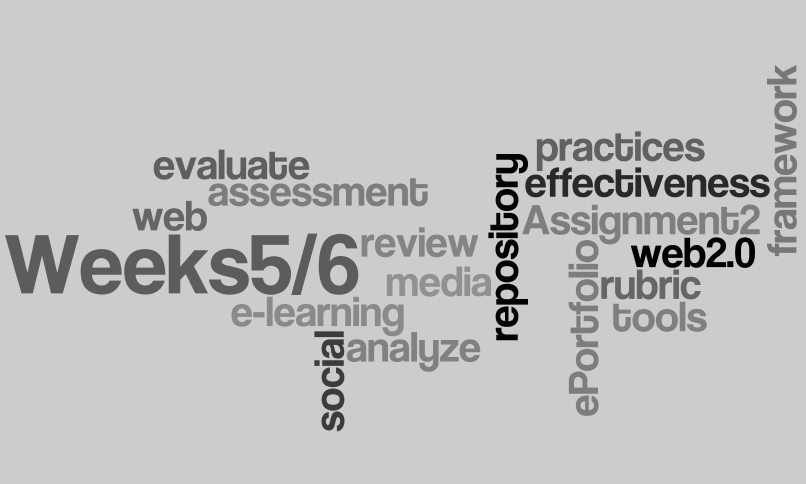Weeks 5 & 6: Building a Repertoire of Web Tools and Examining Assessment Practices
Weeks 5 & 6: Building a Repertoire of Web Tools and Examining Assessment Practices

Intro to Weeks 5 & 6
Audio Transcript
During these two weeks, you will review a variety of social media and web 2.0 tools and evaluate their appropriateness for use in authentic learning and assessment. Based on this individual review, the class will develop a framework for assessing social media and web 2.0 tools and their effectiveness in supporting authentic learning. Refer to Assignment 2 for more details.
During the second week, you will analyze e-learning assessment case studies to identify effective and ineffective assessment practices. The class will develop a rubric that will be used to assess the e-portfolio assignment introduced in week 2 and due in week 12. This rubric will be added to the community-wide repository.
Learning Outcomes for these weeks
1. Apply principles of effective authentic learning and assessment to curriculum planning.
2. Apply key concepts of a learner-centered approach to the design of learning and assessment activities in courses.
3. Communicates effectively in selected media and modes.
4. Use technology to develop and support effective authentic learning and assessment practices.
5. Develop, revise and enhance assessment criteria and rubrics.
6. Select and apply suitable and relevant authentic assessment methods, including peer and self-assessment.
Resources
Required
Boateng, R., Mbarika, V., & Thomas, C. (2010) When Web 2.0 becomes an organizational learning tool: evaluating Web 2.0 tools, - provides a framework to assess web 2.0 tools for organisational learning
Bower, M., Hedberg, J. G., & Kuswara, A. (2010) - A framework for Web 2.0 learning design.
Grosseck, G. (2009). - To use or not to use web 2.0 in higher education?see table 1 models of integrating web2.0 technologies in higher education
Lee, M. J. W. & McLoughlin, C. (2010) 69-75 Beyond distance and time constraints: Applying social networking tools and web 2.0 approaches to distance education. - affordances of technology
Palloff and Pratt (2009) – Ch. 2, pp. 68-83 - designing rubrics; 76-134 skim for examples for journal post
Mertler, Craig A. (2001). Practical Assessment, Research & Evaluation - Designing scoring rubrics for your classroom
Jan Herrington on the role of technology in authentic learning.
change.mooc.org course, week 14: collaborate recording
Weeks 5 & 6 Activities
Assignment 2: Building a Repertoire of Web Tools - As a class you will continue working the scenario we started in week 3. First generate a list of social media and web 2.0 tools <tagged wks5&6 in Diggo> and post to the community-wide repository. Individually, you will review two of these identified tools and indicate how they can be used to support authentic learning activities or assessment practices.
Social media and web 2.0 technologies are interconnected and interactive. Consider web 2.0 as the internet-based technology or tools that enable users to generate their own content within online communities, while social media refers more to the interactions and collaborations users make with each other using these technologies. Grosseck provides a thorough background piece (table 1) on integrating web 2.0 technologies into higher education.
Read Boateng, paying attention to the framework they conceptualise for assessing web 2.0 tools for organisational learning. And read Bower, for another framework for web 2.0 enabled learning design. As a class you are going to develop a “goodness of fit” framework for assessing how specific social media and web 2.0 tools can support authentic learning. Your framework will be a critical resource to use in weeks 7 & 8 as you produce an authentic learning and assessment activity for assignment 3. You will use the framework to assess how well a given social media or web 2.0 tool will work to support a particular type of authentic learning activity. Use the class wiki for collaborating on the activities over these two weeks.
Activity 5: Develop a Rubric - During week 6, in a synchronous online session, the class will develop a rubric to use for the peer feedback component of the ePortfolio assignment. Read the Palloff & Pratt text about rubrics and review Mertler's designing scoring rubrics site. You may also want to revisit the assignment 5 description. Determine which type of rubric, holistic or analytic, should be used for the peer feedback component prior to the synchronous session. The session will be scheduled for week 6 for approximately 60 minutes. As a class you will develop the categories for performance criteria and observable indicators (Mertler) and then break into small groups to further develop each section.
![]() ePortfolio: Continue to add artifacts to your site, some possibilities from weeks 5 & 6:
ePortfolio: Continue to add artifacts to your site, some possibilities from weeks 5 & 6:
- sites of interest
- reflections
- goodness of fit framework
- possible activity to build in wk 7 & 8
- examples of assessment in practice
![]() Journal - One entry for weeks 5 & 6:
Journal - One entry for weeks 5 & 6:
- Analyze elearning assessment case studies – to identify effective and ineffective assessment practices. Choose from the Palloff and Pratt text pages 76-134, the Diigo tagged case studies or choose one of your own assessments. This could be an activity you choose to rework for assignment 3 next week.